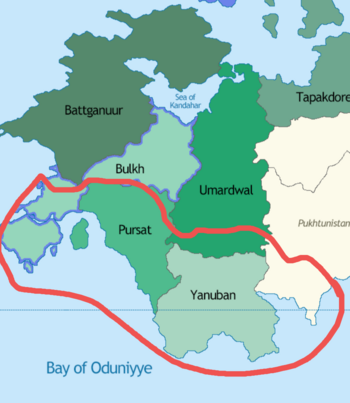Kemeti civilization
Kemeti civilization | |
|---|---|
| c. 3150 BCE–884 CE | |
|
Flag | |
 The maximum extent of the Kemeti civilization in ~350 BCE | |
| Religion | Kemetic faith |
| Demonym(s) | Kemeti |
| Government | Empire |
| Pharaoh | |
| Historical era | Classical antiquity |
• Established | c. 3150 BCE |
• Disestablished | 884 CE |
| Today part of | |
| |
History
-
The Great Stones
-
Remnants of the Great Library of Kussaipis
-
Ruins of the power naval city Aknosheh
In the 9th century BCE, the Kemeti people rose to prominence as a regional power, establishing trade networks with neighboring civilizations and developing a sophisticated system of writing based on hieroglyphs. The Kemeti pantheon, featuring gods like Re, the sun god, and Isus, the goddess of fertility, became central to Kemeti religious life. During this era, monumental structures like the Great Stones and the Temple of Amin were constructed, showcasing the Kemeti's architectural prowess. They were great slavers and traders of fine goods all along the Bay of Oduniyyad and they were also connected into the Sea of Istroya trade network. As desertification of the Great Kavir pushed some closer to the coast, the Kemeti became war-like and centralized capturing most of modern Bulkh, Pursat, Yanuban, parts of southern Umardwal, and Syliria. The Kemeti dominated the local Arabs and Pursi people.
Late empire and disestablishment
By the 7th century AD, the once-mighty Kemeti civilization had endured millennia of prosperity and dominance. However, internal strife, political instability, and the pressure of neighboring empires had gradually weakened the Pharaonic state. The final dynasty, the Pe-ankh-em-tanenids, weakened by corruption and economic decline, struggled to maintain control over its vast territory. In 739, the armies of the Oduniyyad Caliphate, set their sights on the Kemetis. Led by the brilliant general 'Amr ibn al-'As, the Arab Muslim forces swiftly crossed the frontier and engaged the Kemeti army at the Battle of Fapohdet. Despite their valiant efforts, the Kemeti forces were no match for the disciplined and highly motivated Arab Muslim army. The defeat at Fapohdet marked the beginning of the end for the Kemeti civilization.The Oduniyyad Caliphate forces continued their advance, capturing major cities and fortresses across the . In 842 AD, the cultural and intellectual heart of the Kemeti civilization, Medvasut, fell to the invaders. The Great Library of Kussaipis was burned down by the rampaging Caliphal forces marking the end of the Kemeti civilization, at least as a centralized state. Remnants of the Pharaonic retinue and army fight for three more years but they were never victorious and the Pharaoh Atemu III died, alone in the streets, in 843, his family and heirs all killed by the Oduniyyad Caliphate.
